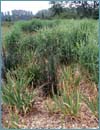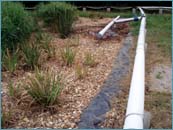

 |
|
|
|||||||||
|
|
|||||||||
|
|
 |
Reedbeds
Reed beds are becoming increasingly popular for the treatment of both industrial and domestic effluents, offering a simple, robust and cost-effective means of wastewater treatment. Reed beds have been applied to the treatment of domestic effluents in rural communities, where the relatively small volumes of effluent may mean that conventional systems are not cost-effective. They are also seen as a 'green' water treatment technology, incorporating fit with the landscape, ecological added value, by providing habitats for wildlife, and sustainability, in addition to significantly reduced operational costs compared to a conventional biological effluent treatment system.
How do they work?
|
What are the benefits of reed beds?
|
 |
 |
Reed beds have a high degree of physical, chemical and biological complexity. The treatment of effluent is achieved by a combination of the microorganisms, the physical and chemical properties of the solid media and the reeds, within the reed bed. The micro-organisms are the most important aspect with regard to the treatment of effluents, utilising the organic compounds present as a source of nutrition. The activity of the microorganisms is influenced by both the reeds and the solid media. Reeds survive in the waterlogged conditions of wetlands by transferring oxygen to their roots. This oxygen is also utilised by the microorganisms in the reed bed. Root growth also restructures the solid media maintaining channels through the bed. Furthermore, due to their spatial complexity, both aerobic and anaerobic conditions will exist in reed beds. This variation in conditions throughout the system results in a high diversity of microorganisms, improving the biological treatment capacity of the system. Additionally, pollutants will be captured, transformed or removed by physical (e.g. filtration) and chemical (e.g. precipitation) routes. For example, metals may be immobilised by cationic bonding to humic acid materials with the solid media or by uptake into the reeds themselves. |
|
 |
 |
W2O is developing Reed bed technology for leather effluent treatment. Reed beds are a promising technology for the developing world, which cannot afford high tech treatment, but still aims to fulfil local discharge compliance. We can offer testing, implementation and start-up of large scale Reed beds for industrial waste water treatment.
Reedbed References
Installation and start-up of a Reed bed pilot plant in China, the Dominican Republic, France and Sweden, 2007-2009 |
 |
 |
 |
|||||||||||

